高中英语语法大全
高中英语语法大全

高中英语语法大全高中英语语法:动词的时态。
(一)动词的时态。
时态动词是谓语动所表示的动作或情况发生时间的各种形式。
英语动词有 16 种时态,但是常用的只有 9 种:一般现在时、一般过去时、一般将来时、现在进行时、过去进行时、现在完成时、过去完。
成时、过去将来时、现在完成进行时。
下面分别介绍。
1、一般现在时的用法(do/does)。
1)表示经常性、习惯性的动作; 表示现在的状态、特征和真理。
句中常用 often, usually, every day, sometimes, every week/year, twice aweek 等时间状语。
例如: a. he goes to school every day. b. he is very happy. earth moves around the sun.。
2)在时间状语从句和条件状语从句中,用一般现在时表示将来。
例如:在时间状语从句和条件状语从句中,用一般现在时表示将来。
例如:a. if you come this afternoon, we’ll have a meeting.b. when i grad uate, i’ll go to countryside.。
3)有时这个时态表示按计划、规定按时间表要发生的动作(句中都带有时间,有时这个时态表示按计划、规定, 按时间表要发生的动作,但限于少数动词状语),但限于少数动词,如:begin, come,。
leave, go ,arrive, start , stop, return,open, close 等。
例如: a. the meeting begins at seven.。
b. the rain starts at nine in the morning.。
4)表示状态和感觉的动词(be, like, hate, think, remember, find, sound 等)常用一般现在进行时。
高中英语全部语法专题大汇总
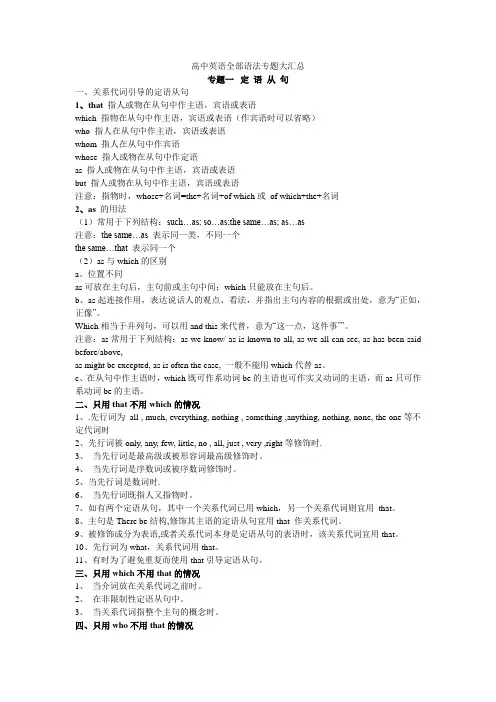
高中英语全部语法专题大汇总专题一定语从句一、关系代词引导的定语从句1、that 指人或物在从句中作主语,宾语或表语which 指物在从句中作主语,宾语或表语(作宾语时可以省略)who 指人在从句中作主语,宾语或表语whom 指人在从句中作宾语whose 指人或物在从句中作定语as 指人或物在从句中作主语,宾语或表语but 指人或物在从句中作主语,宾语或表语注意:指物时,whose+名词=the+名词+of which或of which+the+名词2、as的用法(1)常用于下列结构:such…as; so…as;the same…as; as…as注意:the same…as 表示同一类,不同一个the same…that 表示同一个(2)as与which的区别a、位置不同as可放在主句后,主句前或主句中间;which只能放在主句后。
b、as起连接作用,表达说话人的观点、看法,并指出主句内容的根据或出处,意为“正如,正像”。
Which相当于并列句,可以用and this来代替,意为“这一点,这件事’”。
注意:as常用于下列结构:as we know/ as is known to all, as we all can see, as has been said before/above,as might be excepted, as is often the case, 一般不能用which代替as。
c、在从句中作主语时,which既可作系动词be的主语也可作实义动词的主语,而as只可作系动词be的主语。
二、只用that不用which的情况1、.先行词为all , much, everything, nothing , something ,anything, nothing, none, the one等不定代词时2、先行词被only, any, few, little, no , all, just , very ,right等修饰时.3、当先行词是最高级或被形容词最高级修饰时。
高中英语十二个语法公式
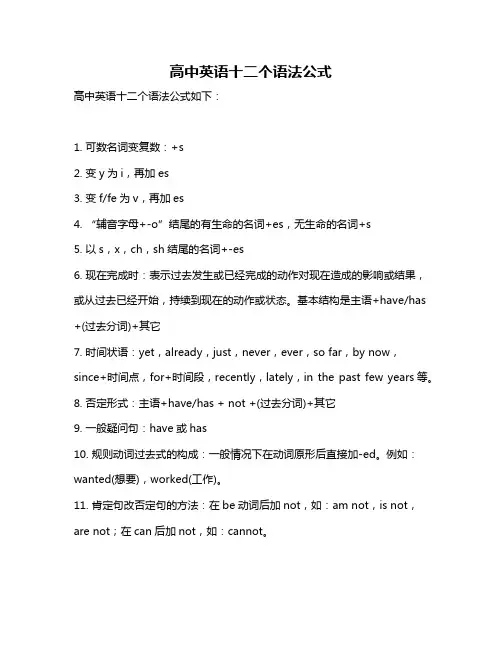
高中英语十二个语法公式高中英语十二个语法公式如下:1. 可数名词变复数:+s2. 变y为i,再加es3. 变f/fe为v,再加es4. “辅音字母+-o”结尾的有生命的名词+es,无生命的名词+s5. 以s,x,ch,sh结尾的名词+-es6. 现在完成时:表示过去发生或已经完成的动作对现在造成的影响或结果,或从过去已经开始,持续到现在的动作或状态。
基本结构是主语+have/has +(过去分词)+其它7. 时间状语:yet,already,just,never,ever,so far,by now,since+时间点,for+时间段,recently,lately,in the past few years等。
8. 否定形式:主语+have/has + not +(过去分词)+其它9. 一般疑问句:have或has10. 规则动词过去式的构成:一般情况下在动词原形后直接加-ed。
例如:wanted(想要),worked(工作)。
11. 肯定句改否定句的方法:在be动词后加not,如:am not,is not,are not;在can后加not,如:cannot。
12. 形容词和副词的比较级和最高级的构成:一般情况直接加-er或-est。
例如:smarter、fastest。
以不发音的字母e结尾的形容词和副词的比较级和最高级加-r和-st。
例如:better、brightest。
重读闭音节词的辅音字母双写构成的形容词和副词的比较级和最高级加-er和-est。
例如:biggest、hottest。
以上就是高中英语十二个语法公式,希望对解决您的问题有所帮助。
高中英语语法大全
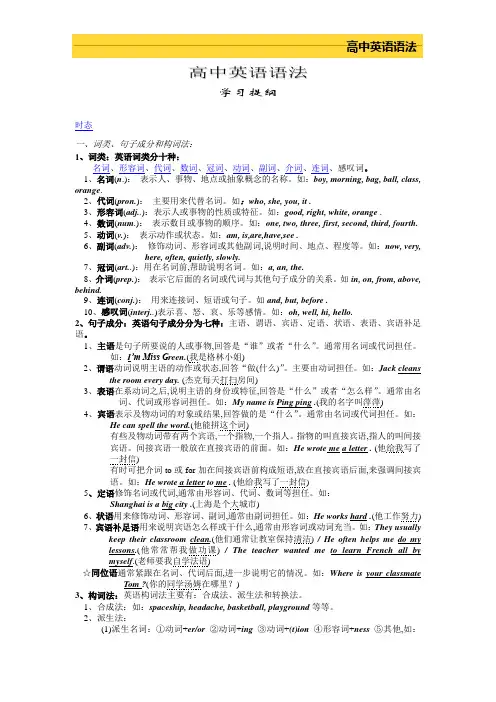
高中英语语法学习提纲时态一、词类、句子成分和构词法:1、词类:英语词类分十种:名词、形容词、代词、数词、冠词、动词、副词、介词、连词、感叹词。
1、名词(n.):表示人、事物、地点或抽象概念的名称。
如:boy, morning, bag, ball, class, orange.2、代词(pron.):主要用来代替名词。
如:who, she, you, it .3、形容词(adj..):表示人或事物的性质或特征。
如:good, right, white, orange .4、数词(num.):表示数目或事物的顺序。
如:one, two, three, first, second, third, fourth.5、动词(v.):表示动作或状态。
如:am, is,are,have,see .6、副词(adv.):修饰动词、形容词或其他副词,说明时间、地点、程度等。
如:now, very,here, often, quietly, slowly.7、冠词(art..):用在名词前,帮助说明名词。
如:a, an, the.8、介词(prep.):表示它后面的名词或代词与其他句子成分的关系。
如in, on, from, above, behind.9、连词(conj.):用来连接词、短语或句子。
如and, but, before .10、感叹词(interj..)表示喜、怒、哀、乐等感情。
如:oh, well, hi, hello.2、句子成分:英语句子成分分为七种:主语、谓语、宾语、定语、状语、表语、宾语补足语。
1、主语是句子所要说的人或事物,回答是“谁”或者“什么”。
通常用名词或代词担任。
如:I‘m Miss G reen.(我是格林小姐)2、谓语动词说明主语的动作或状态,回答“做(什么)”。
主要由动词担任。
如:Jack cleansthe room every day. (杰克每天打扫房间)3、表语在系动词之后,说明主语的身份或特征,回答是“什么”或者“怎么样”。
高中英语语法知识点
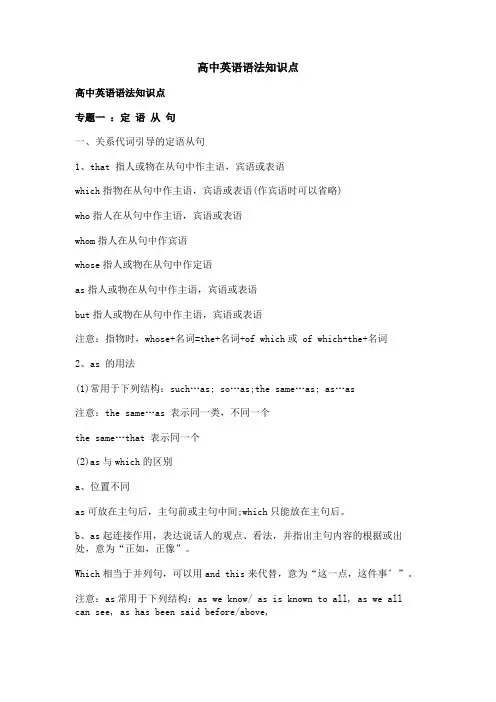
高中英语语法知识点高中英语语法知识点专题一:定语从句一、关系代词引导的定语从句1、that 指人或物在从句中作主语,宾语或表语which指物在从句中作主语,宾语或表语(作宾语时可以省略)who指人在从句中作主语,宾语或表语whom指人在从句中作宾语whose指人或物在从句中作定语as指人或物在从句中作主语,宾语或表语but指人或物在从句中作主语,宾语或表语注意:指物时,whose+名词=the+名词+of which或 of which+the+名词2、as 的用法(1)常用于下列结构:such…as; so…as;the same…as; as…as注意:the same…as 表示同一类,不同一个the same…that 表示同一个(2)as与which的区别a、位置不同as可放在主句后,主句前或主句中间;which只能放在主句后。
b、as起连接作用,表达说话人的观点、看法,并指出主句内容的根据或出处,意为“正如,正像”。
Which相当于并列句,可以用and this来代替,意为“这一点,这件事’”。
注意:as常用于下列结构:as we know/ as is known to all, as we all can see, as has been said before/above,as might be excepted, as is often the case, 一般不能用which代替as。
c、在从句中作主语时,which既可作系动词be的主语也可作实义动词的主语,而as只可作系动词be的主语。
二、只用that不用which的情况1、.先行词为 all , much, everything, nothing , something ,anything, nothing, none, the one等不定代词时2、先行词被only, any, few, little, no , all, just , very ,right等修饰时.3、当先行词是最高级或被形容词最高级修饰时。
高中英语语法大全(详细)
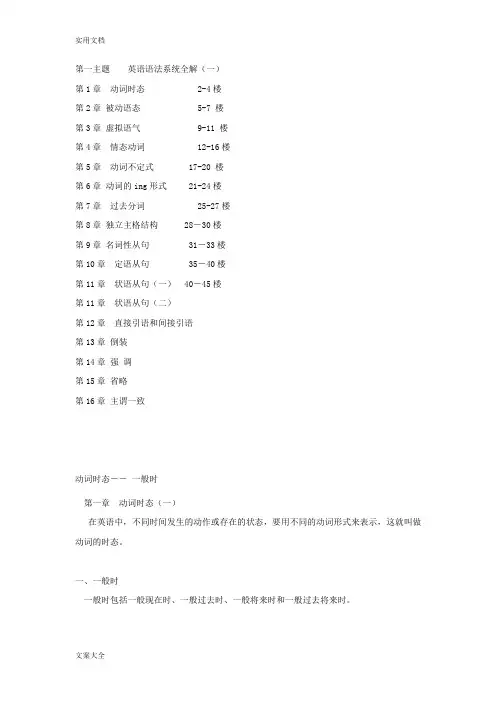
第一主题英语语法系统全解(一)第1章动词时态 2-4楼第2章被动语态 5-7 楼第3章虚拟语气 9-11 楼第4章情态动词 12-16楼第5章动词不定式 17-20 楼第6章动词的ing形式 21-24楼第7章过去分词 25-27楼第8章独立主格结构 28-30楼第9章名词性从句 31-33楼第10章定语从句 35-40楼第11章状语从句(一) 40-45楼第11章状语从句(二)第12章直接引语和间接引语第13章倒装第14章强调第15章省略第16章主谓一致动词时态--一般时第一章动词时态(一)在英语中,不同时间发生的动作或存在的状态,要用不同的动词形式来表示,这就叫做动词的时态。
一、一般时一般时包括一般现在时、一般过去时、一般将来时和一般过去将来时。
A.一般现在时1.一般现在时的构成一般现在时主要用动词原形来表示。
主语是第三人称单数时,动词后面要加-s或-es。
“我’为开头做称呼的是第一人称‘你’怎么怎么样是第二人称‘他她它’是第三人称第三人称就是第三人称转述。
例:小兰对妈妈说:“我要出去玩了”第三人称:小兰对妈妈说,她要出去玩了。
第三人称,就是说是叙述性质的,没有人的语言,是旁白在记叙!以我的角度说,就是第一人称;以和你说的角度说,就是第二人称;站在事情外说事情,他怎么怎么样,那就是第三人称了They want good jobs.他们想要好的工作。
The coat matches the dress.外衣和裙子很相配。
This work does not satisfy me.这项工作我不满意。
Do you understand?你懂了吗?2.一般现在时的用法①一般现在时的基本用法a. 表示现在习惯性的动作或存在状态He always takes a walk after supper.晚饭后他总是散散步。
Everyone is in high spirits now.现在大家都情绪高涨。
b. 表示客观事实或普遍真理The sun rises in the east and sets in the west.太阳从东方升起在西方落下。
(完整版)高中英语语法整理
目录:................................................................................................................... 错误!未定义书签。
1.代词 (2)2.冠词 (8)3.数词 (10)4.名词 (10)5.形容词 (14)6.副词 (14)7.独立主格 (18)8.With的复合结构 (18)9.连词 (19)10.动词 (20)11.系动词 (21)12.助动词 (21)13.情态动词 (22)14.短语动词 (25)15.非谓语动词 (25)补充:worth的用法 (28)16.动词的时态 (32)17.动词的语态 (40)18.主谓一致 (43)19.虚拟语气 (49)20.祈使句 (54)21.反意疑问句 (56)22.倒装 (59)23.定语从句 (61)24.名词性从句 (65)25.状语从句 (69)1.代词1)人称代词的主格在句子中作主语或主语补语。
例如:John waited a while but eventually he went home.约翰等了一会儿,最后他回家了。
说明:在复合句中,如果主句和从句主语相同,代词主语要用在从句中,名词主语用在主句中,例如:When he arrived, John went straight to the bank. 约翰一到就直接去银行了。
2)人称代词的宾格在句子中作宾语或介词宾语,但在口语中也能作主语补语,第一人称在省略句中,还可以作主语。
例如:I saw her with them, at least, I thought it was her. 我看到她和他们在一起,至少我认为是她。
(her做宾语,them做介词宾语,her作主语补语)说明:在上面两例句中,her作主语补语。
现代英语中多用宾格,在正式文体中这里应为she。
高中英语13个语法考点归纳
高中英语13个语法考点归纳高中英语必考的语法是什么1、as 句型(1) as引导方式状语从句句型:“按照……;正如……”例:As(it is)in your country, we grow wheat in the north and rice in the south.正如(像) 你们国家一样,我们北方种植小麦,南方种植水稻。
(2) as+形容词/副词原级+(a /an)+名词+as ;否定式:not as/so --- as例:He is as good a player as his sister.他和他姐姐一样是位优秀的运动员。
(3) such + n. + as to do 如此……以致于……例:She is such a fool as to believe what he said.她是一个如此的一个笨蛋以致相信了他所说的话。
(4) so + adj./adv. + as to do sth 如此……以致于……例:He was so strong as to carry the heavy box.他是如此的强壮以致于能提起那重箱子。
(5) such...as... 象……之类的…… (接名词或定语从句)例:He wished to be such a man as Lei Feng was.他希望成为一个像雷锋这样的人。
(6) the same +名词+as 和……一样的…… (接名词或定语从句)例:He is not the same man as he used to be.他不是从前的那样子了。
(7) as 引导非限制性定语从句例:As is known to us, knowledge is power.众所周知,知识就是力量。
(8)引导时间状语从句,与while意义相近例:We get wiser as we get older.随着我们长大,我们也变得越来越聪明。
(9) 引导原因状语从句,与 because的用法相近例:As it was getting very late, we soon turned back.因为越来越迟了,所以我们不久就回来了。
高中英语语法总结
高中英语语法总结高中英语语法总结一、不定冠词不定冠词a,an与one同源,表示微弱的一的概念,但并不强调数目,用来表示不确定的人或事物。
A用在辅音前,而不是辅音字母前;an用在元音前,而不是元音字母前。
a university in Asia1.表示同类中的任何一个A cat has nine lives.2.表示泛指的某人、某物I know a John Lennon,but not the famous one.3.表示数量的He has a daughter.4. 表示单位数量的每一I earn 10 dollars an hour.5.表示相同的The two birds are of a color.6. 用于集体名词前He grows up in a large family.7. 在某种情况下可用于抽象名词和物质名词前China has a long history.二、定冠词的用法1.表示特定的人或物2.表示地球、宇宙中独一无二的事物主要指各种天体及世界上比较有影响的物体。
The sun,the moon,the earth3.表示地点、方向、时间、方式等 at the corner 在拐角处1) 在表示季节的名词前常不用冠词。
In spring 在春天2) 具体某年的某个季节,需用冠词。
In the summer of the year20083)用于序数词或形容词的最高级前 the first the second4)用于形容词前使其名词化 the rich the poor5)用于复数姓氏前,表示―夫妇‖或全家 The Smiths6)用于乐器名词前 Play the piano7)用于by+the+计量单位名词 By the pound1. 用于复数名词前复数名词泛指某类人或物时,其前通常用零冠词。
Students should obey the school rules. 学生应该遵守校规。
干货高中英语语法归纳总结大全,高考必备
干货高中英语语法归纳总结大全,高考必备1.定语从句引导定语从句的关系代词有that,which,who(宾格whom),所有格whose)和关系副词where when why 等,关系代词或关系副词在定语从句中充当一个成分,关系代词that,which,who,whom等在从句中分别作主语或宾语,whose 在从句中作定语,而关系副词when,where,why等在从句中作状语。
如:①I will never forget the days when/in which we worked together.②I will never forget the days which/that we spent together.解析:在句①中,表示时间的名词the days在从句中充当的是状语,所以用关系副词when来代指,引导定语从句修饰先行词the days;而在句②中,表示时间的名词the days在从句中充当的是动词spent的宾语,所以用关系代词that或which来代指。
同样,表示地点或原因的名词如果在从句中作状语,则用关系副词where 或why 来代指;如果在从句中作动词的宾语,则用which或that来代替。
如:①This is the factory where/in which I worked.(作状语)②This is the factory that/which I visited years ago.(作宾语)注:当先行词为time,reason, place时,引导词可以省略。
①This was the first (when/what) I had serious trouble with my boss.②That is the reason (why) I did it.③This is the place (where) we met yesterday.另外,定语从句中谓语动词的数应与先行词的数相一致。
- 1、下载文档前请自行甄别文档内容的完整性,平台不提供额外的编辑、内容补充、找答案等附加服务。
- 2、"仅部分预览"的文档,不可在线预览部分如存在完整性等问题,可反馈申请退款(可完整预览的文档不适用该条件!)。
- 3、如文档侵犯您的权益,请联系客服反馈,我们会尽快为您处理(人工客服工作时间:9:00-18:30)。
(1)表语从句1.定义:用作表语的从句叫做表语从句。
2.构成:关联词+简单句3.引导表语从句的关联词的种类:(1) 从属连词that。
如:The trouble is that I have lost his address. 麻烦是我把他的地址丢了。
(2) 从属连词whether, as, as if。
如:He looked just as he had looked ten years before. 他看起来还与十年前一样。
The question is whether they will be able to help us. 问题是他们是否能帮我们。
注:从属连词if一般不用来引导表语从句,但as if却可引导表语从句,如:All this was over twenty years ago, but it's as if it was only yesterday.gh能跟表语从句的谓语动词一般为系动词be, seem, look等。
如:It looked as if it was going to rain. 看起来天要下雨了。
连接副词 where, when, how, why。
如:The problem is who we can get to replace her. 问题是我们能找到谁去替换她呢。
The question is how he did it. 问题是他是如何做此事的。
That was what she did this morning on reaching the attic. 那就是她今晨上了阁楼干的。
解释:1.连词because可引导表语从句。
如:I think it is because you are doing too much. 我想这是因为你做得太多。
2.在一些表示“建议、劝说、命令”的名词后面的表语从句中,谓语动词用虚拟语气。
should+动词原形表示,should可省略。
如:My suggestion is that we (should) start early tomorrow. 我的建议是我们明天一早就出发。
(2)主语从句1.定义:用作主语的从句叫做主语从句。
2.构成:关联词+简单句3.引导主语从句的关联词有三类:(1) 从属连词that。
如:That they were in truth sisters was clear from the facial resemblance between them.很明显,她们确是亲姐妹,她们的脸型很相似。
(2) 从属连词whether。
如:Whether he’ll come here isn’t clear. 他是否会来这里还不清楚。
(3) 连接代词who, whom, whose, what, which, whoever, whatever, whichever连接副词 where, when, how, why。
如:What she did is not yet known. 她干了什么尚不清楚。
How this happened is not clear to anyone. 这事怎样发生的,谁也不清楚。
Whoever comes is welcome. 不论谁来都欢迎。
Wherever you are is my home ---- my only home. 你所在的任何地方就是我的家----我唯一的家。
解释:1.主语从句能用it作形式上的主语。
常以it作形式主语的句型有:A. It+be+形容词(obvious, true, natural, surprising, good, wonderful, funny, possible, likely, certain, probable, etc.)+that从句。
如:It is certain that she will do well in her exam. 毫无疑问她考试成绩会很好。
It is probable that he told her everything. 很可能他把一切都告诉她了。
B. It+be+名词词组(no wonder, an honour, a good thing, a pity, no surprise, etc.)+that从句。
如:It’s a pity that we can’t go. 很遗憾我们不能去。
It’s no surprise that our team should have won the game. 我们没赢这场比赛真意外。
C. It+be+过去分词(said, reported, thought, expected, decided, announced, arranged, etc.)+that从句。
如:It is said that Mr. Green has arrived in Beijing. 据说格林先生已经到了北京。
It is reported that China has sent another man-made earth satellite into orbit.据报道中国又成功地发射了一颗人造地球卫星。
D. It+seem, happen等不及物动词及短语+that从句。
如:It seems that Alice is not coming to the party at all. Alice似乎不来参加晚会。
It happened that I was out that day. 碰巧我那天外出了。
E. It+doesn’t matter (makes no difference, etc.)+连接代词或连接副词引起的主语从句。
如:It doesn’t matter whether she will come or not. 她是否来这无关紧要。
It makes no difference where we shall have the meeting. 我们在哪里开会毫无区别。
F. 当that引导的主语从句出现在疑问句中时,要以it作形式主语,而把主语从句后置。
如:Is it true that the scientist will give us a lecture next week? 下周那位科学家将给我们作报告是真的吗?Does it matter much that they will not come tomorrow? 他们明天不来很要紧吗?G. 当主语从句出现在感叹句中时,要以it作形式主语,而把主语从句后置。
如:How strange it is that the children are so quiet! 孩子们这么安静真奇怪!2.注意连接代词whoever, whatever, whichever等引导主语从句的含义Whoever comes will be welcome. (whoever=the person who) 来的人将受到欢迎。
Whatever he did was right. (whatever=the thing that) 他所做的事情是正确的。
Whichever of you comes in will receive a prize. (whichever=anyone of you who) 你们当中不论哪个进来将会得到奖(3)宾语从句1.定义:用作宾语的从句叫宾语从句。
2.构成:关联词+简单句3.引导宾语从句的关联词有三类:(1) 从属连词that。
如:He told us that he felt ill. 他对我们说他感到不舒服。
I know he has returned. 我知道他已经回来了。
注: that在引导宾语从句时也并不是任何情况下都可以省略。
在以下情况下,that不能省略。
1. Everybody could see what happened and that Tom was frightened.(and连接两个宾语从句,that宾语从句放在and的后面时,that不能省略。
)大家都会看出所发生的事情并知道Tom非常害怕。
2.I know nothing about him except that he is from the south.(that引导的宾语从句作介词宾语时,that不能省略。
)对他我一无所知,只知道他是南方人。
3.That he ever said such a thing I simply don’t believe. (that从句位于句首时,that不可省略。
)我简直不相信他曾说过这样的话。
4. We decided, in view of his special circumstances, that we would admit him for a probationary period. (主句谓语动词与that从句之间有插入语,that不可省略。
)鉴于他的特殊情况,我们决定应允他一段试用期。
(2)从属连词if/whether。
如:I doubt whether he will succeed. 我怀疑他是否会成功。
I don’t know if you can help me. 我不知道你能否帮助我。
(3)连接代词who, whom, whose, what, which, whoever, whatever, whichever连接副词 where, when, how, why。
如:Who or what he was, Martin never learned.他是什么人?他是干什么的?马丁根本不知道。
I wonder what he’s writing to me about. 我不知道他要给我写信说什么事。
I’ll tell you why I asked you to come. 我会告诉你我为什么要你来。
You may do what you will. 你可做任何你想做的事。
(1) 介词宾语从句宾语从句也可用作介词的宾语。
如:He was deeply displeased by what had occurred that day.他对那天发生的事感到很不快。
I walked over to where she sat. 我走向她坐的地方。
I am curious as to what he will say. 我很想知道他要说什么。
Your success will largely depend upon what you do and how you do it.你是否成功将主要取决于你做什么和怎样做。
